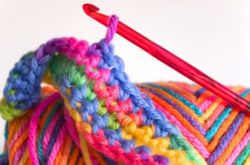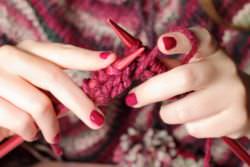Häkeln und Stricken verwenden verschiedene Werkzeuge und Techniken, um aus Garn einen schönen, aber deutlich gemusterten handgefertigten Stoff herzustellen.
Uralte Hobbys, die auch heute noch relevant sind: Häkeln und Stricken feiern ein großartiges Comeback mit Teenagern, Teenagern, Omas und allen dazwischen. Früher als Aktivität für Omas gesehen, um sich zu beschäftigen und mit anderen Frauen in Kontakt zu treten, werden Häkel- und Strickstunden bei jüngeren Frauen überraschend beliebt, weil sie kreativ sind, sich selbst ausdrücken und eine großartige Möglichkeit sind, personalisierte Geschenke für ihre Lieben zu machen.
Contents
Vergleichstabelle
| Crochet | Knitting | |
|---|---|---|
| Introduction (from Wikipedia) | Crochet is a process of creating fabric from yarn, thread, or other material strands using a crochet hook. | Knitting is a method by which thread or yarn is turned into cloth or other fine crafts using knitting needles. |
| Primary tool | Single curved hook | Two or more straight needles (can use one curved needle to make circular items) |
| Accessory tools | Scissors, cardboard cutouts for tassels or fringe, tape measure, row counter | Cable needles, circular needles, scissors, stitch holders, stitch markers |
| Material | Yarn, either animal fiber, plant fiber or synthetic fiber | Yarn, either animal fiber or synthetic fiber; fine metal wire (for jewelry); wax/glass |
| Basic Techniques | Start by creating slip-knot, pull loops through previous loops, wrap material around hook to create post stitches | Start by “casting on” to create first stitches, pull loops through previous loops |
| Mateiral Cost | Hook – 75 cents to $14 for one, depending on material used and function Yarn — $2.99 to $41, depending on the fiber, with acrylic the cheapest and silk the most expensive | Needles — $2.50 to $25, depending on material used and function Stitch holders — $1.85 to $7 Stitch markers — $2.50 to $10 Yarn — $2.99 to $41, depending on the fiber, with acrylic the cheapest and silk the most expensive |
| Basic Look | Posts, loose-tied knots | Series of braids |
| Specialized Stitches | Slip stitch, chain stitch, single crochet, half double crochet, double crochet, triple crochet, double treble crochet, V stitch , shell stitch, butterfly stitch, lover’s knot stitch | Knit stitch, purl stitch, dip stitch, slip stitch, drop stitch, garter stitch, stockinette stitch, seed stitch, rib stitch |
| Products | Caps, sweaters, blankets, doilies, lace, scarves, mittens, earmuffs, table cloths, coasters | Caps, sweaters, blankets, scarves, mittens, earmuffs, socks |
| Difficulty Level | Easier and faster, in addition to a more variety in patterns and weight of fabric. | Not very difficult, but requires two needles and takes more time to finish a product. |
Tools
The only tool crochet requires is one crochet hook; a long shaft with a hook at the end for grabbing the yarn. Knitting requires using two or more straight knitting needles with a knob at the end to prevent the stitches from slipping out.
Knitting needles are generally longer than crochet hooks. Both are available in a variety of materials and sizes. The tools come in metal, wood, bamboo or plastic.
<iframe width=”640″ height=”360″ frameborder=”0″ allowfullscreen src=”https://www.youtube.com/embed/tXtX2kmfO4c?iv_load_policy=3&rel=0″></iframe>
Tool Sizes
Crochet hooks range from 0.4 to 19 millimeters in diameter depending on material and job. Steel hooks used for doilies and lace range from 0.4 to 3.5 millimeters. Plastic, aluminum or bamboo hooks range from 2.5 to 19 millimeters.
Knitting needles in any material range from 2 to 25 millimeter in diameter. For either tool diameter affects stitch size. Crochet hooks are usually 5.5 inches long while knitting needles range from 10 to 16 inches long.

Crochet hook

Knitting with needles
Accessory Tools
For both crochet and knitting, artisans can use several other tools , say scissors, as accessories. Crocheters may also use cardboard to make tassels or fringe, tape to measure the size of the work and a row counter to keep track of crocheted rows.
Knitters use two straight needles for flat work or more for circular knitting. They may use a circular needle, two needles connected by tubing, for circular work. Knitters also use stitch holders and stitch markers to keep track of their stitches when creating complex patterns.
Materials
Both crocheters and knitters use yarn, which normally comes in skeins or balls. The weight of the yarn determines the gauge, or thickness of the fabric . Yarn is categorized according to several factors such as resilience, hairiness, washability and softness. Likewise, yarn is made from animal, plant or synthetic fibers. Animal fibers include wool and silk as well as specialty fibers from goats, rabbits, alpacas and even dogs or cats. Cotton, bamboo, hemp, yucca, flax and jute are all examples of plant fibers. Synthetic fibers come from materials such as nylon, polyester and acrylics. For both, wool is the most commonly used material.
Knitting can also be used in conjunction with unusual materials. Knitters can use fine-spun metal to create pieces of jewelry . They can also created knitted glass. To do this they knit with wax and cover the work with heat-resistant material. They melt the wax out, resulting in a mold for glass.
Which is Easier?
Crochet and knitting are both relatively easy, in the sense you don’t need to have any prior experience or knowledge in the subject. But like any new skill, both have a specific technique and require patience to master the dexterous hand movements and finesse in product. Crochet is considered faster and easier by some – a crochet scarf can be finished much sooner than a knit one. Others consider crochet easier because if you accidentally let go with one of the needles in knitting your whole stitch crumples, while in crochet nothing bad happens if you lose the hook. The following section talks about the basic techniques along with some demonstration videos.
Basic Techniques
Though both involve pulling loops of yarn through previous ones, crochet and knitting differ particularly in the techniques used.
Crocheters start by making a slip knot and using the hook to create a chain. They then either turn the stitches and crochet in rows or close the chain and work in circles. The technique involves holding the yarn and piece in one hand and the needle in the other. They hook the yarn through the chain and preceding rows to create posts of loose knots. Only one loop is left on the hook at the end of a stitch. Stitches only support the stitch on either side, minimizing unraveling. The resulting fabric is usually fairly thick. This is a good starter video for crocheting 101.
Knitters start by casting on, or creating the first stitches. During the process, they keep hold of the active stitches with one needle while securing them with the other. Once secured they release the stitches. Just like with crochet, knitting involves pulling loops of yarn through other loops. Knitting simply has more active loops at any given time. To create pieces in the round, such as sweater sleeves, knitters must either use more than two needles or a circular needle to keep all the stitches in place. Knit stitches support the row below and are supported by the row above, creating what looks like braids. Knit stitches unravel more easily than crochet. Knitting often uses less yarn than crochet, making the resultant fabric lighter. Watch this video to learn the basics of knitting.
Arm Knitting
The Wall Street Journal reported that some people have begun using their arms instead of needles to produce chunky yarn creations. In this video, WSJ’s Rachel Dodes shows how to arm knit:
<iframe width=”515″ height=”300″ frameborder=”0″ src=”https://video-api.wsj.com/api-video/player/iframe.html?guid=F772C197-E8E4-4C75-BCB9-A0F05013085A”></iframe>
Specialized Stitches and Products
Both crocheters and knitters utilize specialized stitches in their work. In addition to the slip stitch and chain stitch that start a crochet piece, basic stitches include the single, half double, double, triple and double treble crochet. These all relate to how many times the crocheters wraps the yarn around the hook to make a post. To create specialized stitches, crocheters use variations of those basic stitches. For a V-stitch, two stitches are worked into one loop. To create a shell, crocheters work more than one stitch into a single loop. A butterfly stitch consists of three or more chains looped together in the center. A lover’s knot is a very loose stitch secured at the top.
The basic stitches for knitting are the knit and the purl. During knitting, stitches pass through the previous loops. If they pass through from below, this is a knit or plain stitch. If they pass through from above, this is the purl stitch. Just like with crochet, specialty stitches stem from these basics. If a knitter uses all knit or all purl stitches, the result is the garter stitch. If the knitter alternates rows, the result is the stockinette stitch. Alternating columns of knit and purl stitches results in the rib stitch. Alternating knit and purl stitches both horizontally and vertically results in a seed stitch. A dip switch is a stitch secured between two already secured stitches, producing a stippling effect. Slipped stitches get left unsecured until a later row, resulting in taller stitches. Sometimes a stitch is deliberately left unsecured and allowed to disassemble, resulting in loose holes in the fabric. This is called a drop stitch.
Though knitting tends to create more give in the fabric, both crochet and knitting can be used to make caps, sweaters, blankets, scarves, mittens and earmuffs. Due to the series of knotted posts in crochet, the techniques lend themselves better to delicate work such as doilies and lace. Knitting is the preferred technique for socks.
References
- Knitting and Crochet – jennlikesyarn.com
- Wikipedia: Crochet
- Wikipedia: Knitting
- Wikipedia: History of knitting
- Corchet Stitch Instruction
- Knitting stitches – dummies.com
